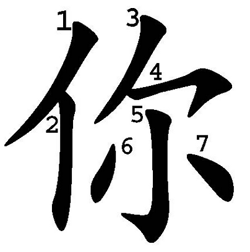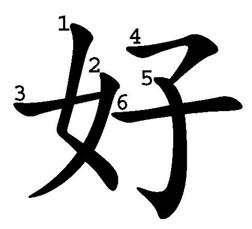

- Home
- First contact
- Writing
Chinese characters
At the centre of Chinese writing is the Chinese character. Each character represents both a syllable and is associated with one or more meanings. While there are about 1500 syllables, taking into account tones, the number of characters is much larger and potentially unlimited. An educated native speaker might recognize around 6000 characters and for basic reading competence knowledge of about 2500 to 3000 characters is required. Each syllable therefore tends to be associated with a number of different characters.
Since characters are associated with meaning they can and often do function as words. In classical Chinese words and characters mostly coincide with the context providing any disambiguation between the multiple possible meanings of a character. In modern Chinese however the majority of words consist of one or two characters, although longer words also occasionally occur. Frequently, one and two word versions co-exist with the shorter version used in non-ambigous contexts or for rhytmical reasons.
Chinese characters have been in evidence at least since the fourteenth century BC and most characters written after the standardization in the Qin dynasty are recognizable by modern readers of Chinese. The simplification of Chinese characters in the 1950s has not fundamentally changed this situation.
Each Chinese character is made up of a number of strokes. These strokes are written in a fixed order and with a specific direction. Regular characters are written in an imaginary square and take the same amount of space irrespective of their complexity. Look at the example of 水, water below. It shows the stroke order and illustrates most of the basic strokes and their direction.

There are a relatively small number of pictographic or ideographic characters where the form of the character shows some resemblance to the visual representation of its meaning. 山 meaning mountain is an example of a pictographic character while 上,on, top/ and 下, down, under are examples of ideographic characters. They form simple characters. Most characters however consist of two or more components where the components themselves are either simple characters, sometimes slightly modified, or complex components. In the majority of cases one of the components gives a hint of the pronunciation while the other hints at the meaning. The character 吗 (ma) for example is made up of 口 (kǒu) meaning 'mouth' and 马 (mǎ) meaning 'horse'. 口 is often used in characters whose meaning is related to speaking, making sounds and the like while 马 gives a clue to the pronunciation. Spotting the components in characters is crucial to learning them as well as useful in guessing an unfamiliar characters meaning and pronunciation.
Here are two very common characters to start:
The stroke order is:

好 (hǎo), good, has the two components 女 (nǚ) female and 子 (zǐ) child. This is a meaning-meaning component, ie, women + child suggest 'good'. 女 appears in many other characters where the meaning is related to someting female. Both 女 and 子 can also appear as independent characters.
The stroke order is:
